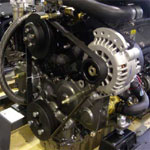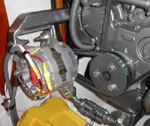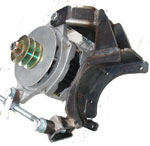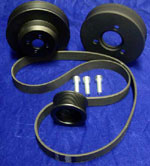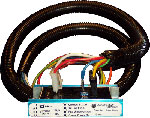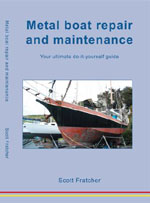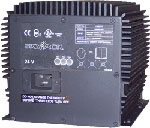Solving marine diesel engine mysteries
By: Scott
Fratcher - Marine Engineer/Captain
In this article were going to discuss the three most common engine
mysteries and how to solve them. The reason we are calling these engine
issues "mysteries" is because our engine seems ready to function,
but for some reason it will simply not perform. This can be frustrating
and time consuming.
By learning these common engine faults the boat owner can save money
and time resulting in more enjoyment on the water.
The mysteries are:
* We push the start button but the engine does not turn over
* A diesel engine that turns over but won't start
* We leave the dock and our engine won't reach rpm's
Lets look at each of these mysteries in turn.
Mystery #1
We push the start button, but the engine does not turn over
Nothing can make a botie take a quick breath faster than pushing the
start button and having no response from the engine. If we listen carefully
we may hear a click or grinding noise or maybe a very slow turning engine.
Lets look at what each of these sounds means and how to quickly get
our engine turning over.
We'll start with a quick review of how our starter circuit works and
then we'll talk about the common reasons this robust system may suddenly
fail. Starting an engine takes a lot of energy for a short period of
time. The energy starts inside a battery stored in a chemical reaction.
When the start button is pushed a small current is passed to an electro
magnetic switch (solenoid) that both engages the gears of the starter
and closes a big switch to pass the 250+ amps it takes to turn the engine
over.
Lets go back to our first scenario of "push the start button"
and we hear a simple "click". This often means the first step
of the start process has taken place. The electro magnetic switch has
attempted to engage the starter gear, but no current was passed to the
starter. This could be due to an old solenoid having dirty contacts
or dirty starter brushes or a seized starter or engine.
The first test to narrow down the possibilities is to turn on the dash
lights and watch them carefully as we attempt to start the engine. If
the lights dim considerably during a start attempt this is a bad sign
and could mean a seized starter or engine.
The seized starter could be from corrosion in the starter that caused
the inner workings to swell to the point they will no longer move, or
possibly the engine has "hydro locked" (See Tradeaboat Aug).
If the gauge lights did not dim, but the starter made a click this
means the starter gears are attempting to engage, but the big switch
in the starter did not close, or the starter brushes have worn out and
are no longer making electrical contact. This can be considered a good
thing as changing a solenoid or starter brushes is within the capabilities
of most DIY boties.
Tip-In this scenario we can often use the plastic handle of a screwdriver
and give the solenoid body a good solid "thunk" giving us
one or two more starts. This "thunk" works because the vibration
loosens just enough dirt to allow one or two more electrical contacts.
If the starter made a simple "growling" or "grinding"
noise this is most often caused by the small "sprag" clutch
inside the starter failing. Luckily the sprag clutch tend to give us
warning by failing over time and by trying the start a few times we
can normally get the engine to start getting us home to make repairs.
If we hear a very slow turning engine this could be a failed battery,
shorted starter winding or loose cables. The next test is to check voltage
and amp draw at the starter during a start attempt. If the voltage drops
out below 9.5 volts during the start attempt and draws less than 250
amps, then we have a cable or battery problem. We can work our way backwards
along the big power feed cable looking for electrical lugs to test voltage
till we reach good voltage or the battery. Clean or tighten that connection
and the engine should start.
If we had less than 9.5 volts and over 250 amps then we probably have
a starter winding that is beginning to short. This repair is within
the capability of most DIY techs.
If you heard no click, and no light dim during start attempt then check
voltage at the solenoid control circuit at the starter. The control
cable is the small wire to the spade connection located directly on
the solenoid. If the control cable has 12 volts during a start attempt
then the problem is in the starter, but if it shows no voltage then
the problem is in the ignition wiring. Look for a safety lockout (IE
engine in gear), or bad start button.
Mystery #2
A diesel that will turn over, but not start
This common fault can cause a world of frustration. The engine turns
over and over but simply will not "catch". We'll take detailed
look at why this phenomena becomes a mystery, but fist lets have a quick
review of what an engine needs to start.
To start a diesel we need
* Clean fuel
* Air
* Heat
Clean fuel means clean, bubble free diesel. Air means a continual circulation
of fresh, oxygen rich air, and heat comes from compression and/or glow
plugs. This combination must occur for our engine to start.
Fuel is what most boties turn to when an engine will not start, but
fuel is often the least of our starting problems. Of course we need
clean bubble free fuel, but once we have turned the engine over a few
times we risk injecting too much fuel that in effect floods our combustion
chamber reducing our chances of an engine start.
Another source of complication is the seawater pump. During repeated
start attempts the seawater pump is still turning over and filling our
exhaust hose muffler/water trap. This means our engine is trying to
start against backpressure. Backpressure means a restriction on the
outlet side of the engine so less air circulation and thus less of a
chance of our engine starting. For this reason we close the seawater
pump inlet valve during long start attempts. Remember to open the valve
soon as the engine starts.
Heat is another often overlooked process in starting a diesel engine.
Heat is a result from compression. Compression is often lowest when
attempting to start. Heat can be increased by turning the engine over
faster, leaving the glow plugs to heat longer, and verifying our valves
are set as they should be.
Lets look at the steps to fixing a diesel engine that turns over but
will not start.
1. Turn on the battery charger so we have maximum rpms while turning
the engine over.
2. Close the seawater intake throuhull (remember to open it as soon
as the engine starts).
3. Loosen the injector fuel tube nuts right at the injector. Let a little
clean fuel flow. This might dislodge a small amount of trapped air in
the injection pump.
4. Remove the rubber exhaust hose at the junction where it attaches
to the engine. This will prevent the build up of backpressure and often
allows the engine to jump to life. Again remember to only run the engine
for a few seconds before shutting down and reconnecting the exhaust
system.
5. Verify the inlet and exhaust valves have lash. You should be able
to turn the engine over by hand and check for free movement (lash) in
each valve rocker arm. Tight valves leak compression.
6. Spray a small amount of WD-40 into the air intake while trying to
start. WD-40 is a light oil that enters the cylinder pre-mixed with
air. It's a little more flammable than diesel, but not so "explosive"
as starting fluid. If the engine will start on WD-40, but shuts down
immediately after you stop spraying then the problem is assuredly fuel
related.
If these six tricks do not start a stubborn engine the next step is
a compression check, but most times when a technician gets called to
a obstinate starting engine the problem is solved by one of the six
steps above.
Tip-An easy way to start a flooded outboard engine is to give full
throttle and turn the choke off and give few quick pulls. The full throttle
will open the butterfly valve thus reducing the intake manifold vacuum
allowing air to circulate in the combustion area of the engine drying
the flooded gas. Remember to be ready to quickly twist the throttle
back to idle once the engine starts.
Mystery #3
An engine that seems to run fine at the dock, but underway simply won't
push the boat to speed
The engine runs fine at the dock or in neutral, but when we try to
get up to speed we can't reach rpm's. Maybe we can only reach half speed,
but we the defining fact is as we push the throttle forward we seem
to get no reaction from the engine.
This is a very common problem and one technicians have become adapt
at solving. Still the first time it happens on a boat the drivers often
has to take a double look at the slow progress of water passing the
hull.
When an engine cannot obtain its rated rpm's we have to look at the
possibilities. Lets start with air. Look at the exhaust under load.
Is it deep black and cloud like? If so the problem is probably air related.
Either a clogged air filter, a turbo that is not spooling up or clogged
exhaust system.
Black smoke could also mean an overloaded engine. A dirty bottom or
barnacle covered prop are classic reasons why an engine will not reach
the rated rpm's. If this is the case we should also see high exhaust
gas temperatures.
If the exhaust looks clean we begin to suspect to our fuel system.
We may have a classic case of faulty lift pump or semi clogged fuel
filter. In this situation we find the injection pump is able to supply
almost enough fuel to provide most of our needed horsepower, but not
quite enough to get us to speed. In this situation we would have a clean
exhaust, and cool exhaust gas temperature. It's not much a problem except
the engine simply does not have the fuel to produce the needed horsepower.
The simple check is to find a place to crack open the fuel return line.
Diesel should be flowing back to the tank. If not this is a sure sign
the engine is starving for fuel, but no so starved it shuts the engine
down, thus the mystery.
|

